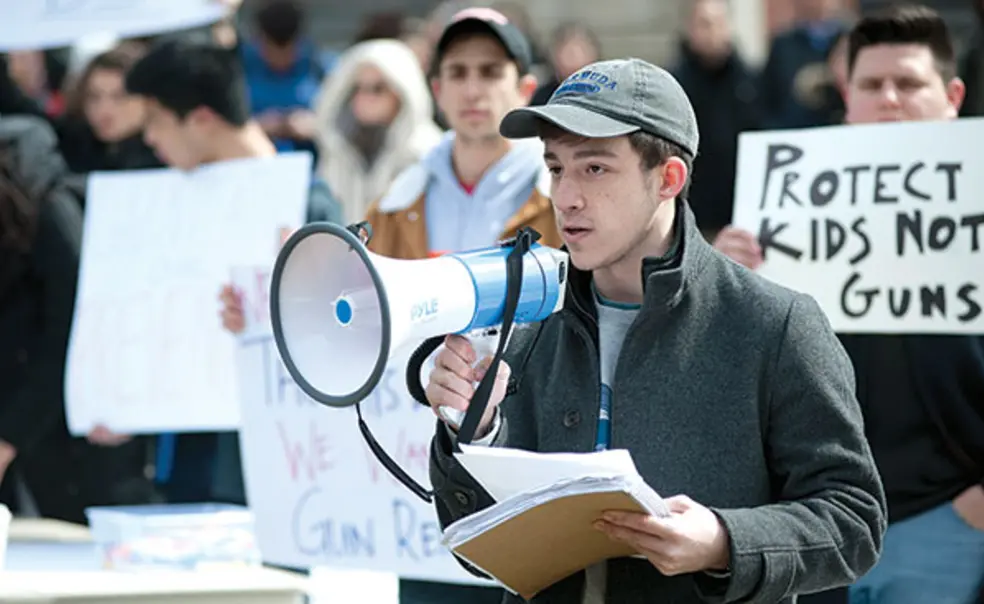Speaking Out on Guns
On a day of protests across the country, campus event draws more than 400
More than 400 students and community members gathered in front of Frist Campus Center March 14 to rally against gun violence and advocate for stronger gun laws on a day of nationwide school walkouts and protests. Protesters offered personal stories, chanted, held up signs, and registered voters.
“So many people came from all different aspects of campus,” said Diego Negron-Reichard ’18, co-founder of Princeton Advocates for Justice, which organized the event. “The campus is fired up.”
The event was held one month after the school shooting in Parkland, Fla., in which 17 people died. Students shared experiences of gun violence in their own communities, such as the shooting of a school official or a friend. One speaker emphasized that the impacts of gun violence disproportionately affect black Americans.
“The right to arms is not absolute,” Sarah Sakha ’18 said. “It does not trump the right to life.”
Organizers said they were pleased with the turnout. Ben Bollinger ’21, leader of the newly formed Princeton Against Gun Violence advocacy group, said in an email that it was “flooded with new sign-ups” after the rally.
Bollinger said the group planned to meet with other grass-roots organizations seeking gun-reform legislation and was scheduling an event to phone New Jersey legislators later in the month. “We’re firing on all cylinders, trying to get people involved,” he said.
The Gun Safety Club, a student organization that says it promotes firearms safety, interest in shooting events, and education about current gun issues, set up a table near the protest to offer an alternative viewpoint to those attending the rally. “It is up to us to represent in a civic manner a view that is underrepresented,” said Chance Fletcher ’18, a member of the club.
Many protesters approached the Gun Safety Club table to question the members or to present opposing views, club president Mikhael Smits ’18 said, but the atmosphere was respectful and cordial. Both Smits and Negron-Reichard said they felt supported by the University to express their views.
Yael Niv, associate professor of psychology and neuroscience, was one of several faculty members attending the rally. “As an Israeli, I think gun control (or lack thereof) in this country is one of the worst problems, and the one I am least in power to address with personal life choices,” Niv said in an email. “If guns become allowable on campus and in schools, I literally might have to leave the country to go back to sanity.”
The University issued a statement about admission applicants’ right to protest that said, in part: “Students who act on their conscience in peaceful, principled protest will receive full consideration in our admissions process.”











2 Responses
David Grundy ’58
7 Years AgoHelp Gun-Control Activists
Hats off to the demonstrators on campus March 14 who advocated stronger gun laws (On the Campus, April 11)! I’m afraid, though, that the claim from one participant that “the right to (keep and) bear arms is not absolute” has run into a stone wall from the uncooperative NRA over the years.
Such stubborn resistance has prevented much useful action in the past, a situation deplored recently by retired Supreme Court justice John Paul Stevens. He echoes a blast in 1991 from another retired justice, Warren Burger, that the argument that the Second Amendment protected individual gun rights was the biggest fraud he’d ever encountered.
Both were complaining about the NRA’s high-handed manner, after it was taken over by extremists in 1977, to manipulate the public’s conception of the Second Amendment. Its new leader, Harlon Carter, boasted that the NRA would be recruiting lawyers, constitutional scholars, etc., “to provide the means to save (sic) the Second Amendment.”
It might be worthwhile for the faculty of a major university to help students in a group like Princeton Against Gun Violence to pin down the evidence that there is no way the Second Amendment can be seen as still existing. They might begin with The First Congress by Fergus Bordewich (2016) and its useful mention of the Vining committee, which in 1789 made sure an all-important conditional clause was included at the beginning of the amendment’s clearly stated final version.
Bertrand de Frondeville p'88
7 Years AgoThe Heller Decision Says It All
Congratulations to Bollinger and Smits and both their advocacy groups for gathering in peaceful dialogue on gun rights. But I wonder why any concerned person does not simply refer to the 2008 Heller decision of our U.S. Supreme Court, where Justice Scalia spent much time proving that every citizen is concerned rather than only members of a militia, as too many believe. He then summarized:
"- The Constitution holds that guns may be owned by any citizen for sport or defense against criminals.
- However, there are long-standing restrictions:
- No weapons for the criminal and the mentally ill (which means a database to be checked for any sale)
- No right to own automatic weapons such as machine guns (now including AK47 or special devices)
- No right to bring weapons into sensitive buildings such as schools, government buildings or the like."
WHAT ELSE IS NEEDED? And yet no one refers to this in the animated discussions of the subject.
I sent this to the mayors association: We can't wait for our Best Congress (NRA) Money Can Buy, alas!